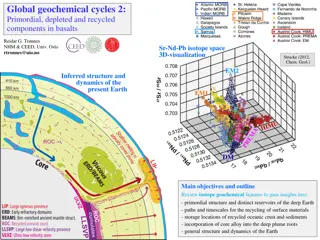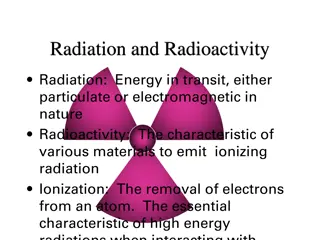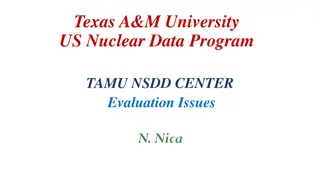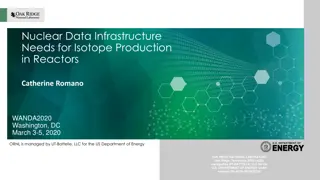Understanding Radioactive Decay and Nuclear Radiation
Radioactive decay is the process in which unstable atomic nuclei emit charged particles and energy, transforming into different elements. This process involves the emission of alpha particles, beta particles, and gamma rays. Alpha particles consist of two protons and two neutrons, beta particles are
4 views • 31 slides
Overview of Particle Accelerators and Isotope Production Methods
Explore various types of particle accelerators such as Direct Voltage Accelerators, Van de Graaff Generators, Tandem Van de Graaff Accelerators, and Linear Accelerators used in generating particles for isotope production, research, and industrial applications. These technologies play a crucial role
3 views • 22 slides
Quantum Physics Research on Electron Wavefunctions and Double-Beta Decay
Researchers at the University of Tsukuba study electron wavefunctions using the Dirac equation and analyze double-beta decay in nuclei. The calculation of phase space factors, nuclear matrix elements, and bound and scattering states of electrons are explored to understand fundamental particles and t
0 views • 12 slides
Understanding the Rb-Sr Method of Dating in Geochemistry
Explore the principles of the Rb-Sr dating method in geochemistry, focusing on radioactive decay of Rubidium and Strontium isotopes in geological materials. Learn about isotope data presentation, application in dating geological processes, and the significance of Rb and Sr in the periodic table.
3 views • 62 slides
Insights into Earth's Geochemical Cycles and Isotopic Evolution
Explore the primordial, depleted, and recycled components in basalts to understand deep Earth reservoirs, recycling paths, and core-mantle dynamics using isotope geochemistry. Learn about radioactive decay systems, mantle array evolution, and U-Th-Pb systematics in planetary differentiation.
6 views • 30 slides
Rare Isotope Beams from FRIB - Facility Overview and Operations
FRIB (Facility for Rare Isotope Beams) is supported by the U.S. Department of Energy and Michigan State University. It utilizes advanced techniques for rare isotope beam formation, offering insights into nuclear physics. The facility operates with high beam power, serving various scientific experime
0 views • 15 slides
Understanding Exponential Decay in Ibuprofen Dosage
Explore the concept of exponential decay using an example of ibuprofen dosage elimination from the bloodstream. Learn how to calculate the remaining dosage at different time intervals based on the decay rate. Discover the relation between the initial dosage, elimination rate, and time passed.
2 views • 22 slides
Understanding Forgetting: Theories and Influence on Memory Recall
Forgetting is a complex phenomenon influenced by theories such as Decay Theory, Interference Theory, and Motivated Forgetting. The Ebbinghaus forgetting curve highlights how memories fade over time. Decay Theory suggests memories decay over time, while Interference Theory explains how old and new me
0 views • 25 slides
Understanding Radioactivity and its Particles in Radiochemistry
Radioactivity involves the spontaneous decay of unstable atomic nuclei, releasing radiation in the form of alpha particles, beta particles, and gamma rays. Alpha particles are heavy and have low penetration, beta particles are light and faster, while gamma rays are high-energy waves with great penet
1 views • 20 slides
Exploring Radioactive Decay: A Half-Life Lab Simulation
Explore the concept of radioactive decay through a virtual lab simulation involving strontium-90 (Sr-90) and yttrium-90 (Y-90) isotopes. Witness the decay process over multiple half-lives as unstable atoms transform into stable nuclei. Dive into the intricacies of half-life measurements and the vast
0 views • 10 slides
Understanding Radioactivity: A Comprehensive Overview
Radioactivity is the spontaneous decay of unstable atomic nuclei, emitting alpha, beta, or gamma rays. This phenomenon is regulated by Massachusetts laws, with institutions like Clark University licensed for responsible use. Alpha decay involves emission of helium nuclei, while beta decay releases e
0 views • 39 slides
Understanding Radiation and Radioactivity in Science
Radiation is energy in transit, while radioactivity is the emission of ionizing radiation by materials. This process involves ionization, which removes electrons from atoms, leading to various nuclear decay processes such as alpha decay, beta decay, gamma-ray emission, positron decay, electron captu
0 views • 80 slides
Nuclear Data Recycling Using NuDat Programs
Explore the use of NuDat classes in plotting beta-minus decay half-lives, electron capture processes, reliable ECp values, and antineutrino spectra calculations. Delve into topics like cross-section spectra, thermal fission yields, and the decay of various nuclides. The research also discusses assum
0 views • 14 slides
Nuclear Physics Research Highlights: Neutron Stars, Nuclear EOS, and Pb Isotope Studies
Explore cutting-edge research in nuclear physics, including experiments on pion ratios and Pb isotope radius measurements, neutron star observations, neutron density distributions of Pb isotopes, and polarized proton beams at Osaka University. Learn about the analysis of realistic point proton densi
0 views • 26 slides
Isotope Production Charged Particle Cross Section Techniques
The process of measuring angle-integrated charged-particle cross sections using the stacked target technique is discussed. The method involves the use of monitor foils, degraders, and a beam foil of interest to determine energy and flux. Uncertainties in the measurements and the correction for flux
1 views • 3 slides
Exploring Nuclear Equations and Beta Decay in Physics
Understanding the development of scientific theories like beta decay and nuclear equations through the work of Enrico Fermi and Chien-Shiung Wu. Discover the collaborative nature of scientific progress, where experiments validate theories and correct errors. Scientists worldwide, including George Ga
0 views • 7 slides
Challenges in Nuclear Data Program Evaluation and Remedies
Exploring evaluation challenges in a nuclear data program, including issues with decay cases and ambiguous notations. Remedies such as redesignating levels and clarifying decay probabilities are discussed to address these challenges.
0 views • 7 slides
Exploring Explanations of Forgetting in Memory
This content delves into various explanations of forgetting in memory, such as trace decay, displacement, interference, retrieval theory, and motivated forgetting. It discusses why people forget and evaluates these theories. Additionally, it explores the Multi Store Model of Memory and concepts like
0 views • 74 slides
Understanding Radioactive Dating Methods
The process of radioactive dating involves utilizing the decay of radionuclides to measure time intervals, with applications in determining the age of rocks and artifacts. Techniques such as radiocarbon dating, based on isotopes like 14C, enable scientists to determine the age of organic materials b
0 views • 4 slides
Enhancing Resilience: US Insurers' Role in Combating Infrastructure Decay and Climate Challenges
Explore how US insurers can contribute to resilience-building efforts amid infrastructure decay and climate-related challenges. The discussion covers historical perspectives, public-private partnerships, notable climate disasters, and the imperative for proactive action by policymakers. Discover the
2 views • 21 slides
Reflections of Decay: Edgar Allan Poe's Dark Journey
The content delves into the exploration of decay within the soul of a person and how it might manifest in their personality, clothing, lodging, and outer appearance. Through a series of thought-provoking questions, literary excerpts, and historical insights, the essence of decay and its potential ma
0 views • 11 slides
Magnetization, Decay, and Error Fields in HTS Accelerator Magnets
The research conducted at The Ohio State University focuses on understanding the magnetization, decay, and influence of error fields in high-temperature superconducting (HTS) accelerator magnets. The study explores the impact of different superconducting materials such as Nb3Sn, YBCO, and Bi:2212 on
0 views • 21 slides
Understanding Nuclear Decays and Reactions in Stellar Astrophysics
Nuclear decays and reactions, driven by weak interactions, are vital in stellar astrophysics. Various processes like bound-state beta-decay impact nucleosynthesis and cosmochronology. Specific processes in stars involve capture reactions, electron capture, and neutrino-nucleus interactions. Stellar
0 views • 22 slides
Quality Education for a Healthier Scotland - Smile4life Initiatives and Oral Health Awareness
Explore Smile4life's programs focused on promoting oral health across Scotland. Learn about giving health advice, understanding the importance of oral health, and combating tooth decay through education. Discover key messages on diet, hidden sugars, and tooth decay prevention. Dive into the findings
0 views • 30 slides
Investigating Agent Z's Poisoning: A Case of Radioactive Decay
Agent Z, a double spy, was poisoned with Polonium-210, a heavy, radioactive element. This task challenges students to analyze the cause of his death using concepts of nuclear decay and half-life modeling based on provided data and models. The scenario involves understanding the effects of radioactiv
0 views • 14 slides
Importance of Oral Hygiene and Preventing Tooth Decay in Children
Understanding the significance of oral hygiene and preventing tooth decay in children is crucial for their overall health. By learning about dental plaque, causes of tooth decay, effective teeth brushing techniques, and the impact of sugary foods and drinks, children can take steps to maintain good
0 views • 21 slides
Understanding Hydrogen Isotope Influence on H-Mode Confinement in Fusion Plasmas
Knowledge of how the hydrogen isotope impacts H-mode confinement is crucial for predicting energy confinement in future fusion plasmas. Research explores the relationship between isotope mass and confinement time, highlighting the optimistic outlook for future reactors. Experimental studies on hydro
0 views • 13 slides
Analysis of Tune Variation and Decay in Large Hadron Collider
This analysis focuses on the tune variation and decay of the bare machine tune in the Large Hadron Collider. It covers the evolution of the bare tune, analysis of the tune decay after injection, fitting of decay constants, and data extraction from 2015. The study includes insights into beam commissi
0 views • 16 slides
Understanding Compound Growth and Decay Through Examples
Compound growth and decay, specifically compound interest, involve calculating interest on a changing total amount over time. This concept is illustrated through various examples and equations, showcasing how investments or values increase or decrease with each period. Learn how to solve problems re
0 views • 9 slides
Understanding Radioactive Decay and Isotopes in Chemistry
Explore the fascinating world of radioactive decay, isotopes, and nuclear transformations in this educational resource. From reviewing atomic numbers to illustrating alpha and beta decay processes, discover the fundamental principles behind these phenomena with detailed explanations and visuals. Del
0 views • 17 slides
Advancements in Rare Isotope Research at EURISOL Town Meeting
Cutting-edge research and facility developments in the field of rare isotopes were showcased at the EURISOL Town Meeting in INFN - Pisa. Topics included advances in EBIS charge breeders, the ARIEL Extension facility, and the CANREB laboratory with Electron Beam Ion Source technology. Various aspects
0 views • 39 slides
Copper-67 as a Medical Isotope: Potential and Production Methods
Copper-67 (Cu-67) is a promising medical isotope due to its biological compatibility, short half-life, and dual treatment and imaging capabilities. This isotope offers non-toxicity, desired decay modes, and suitable half-life for medical applications. Various production methods, such as rare isotope
0 views • 7 slides
Advances in Medical Radioisotope Production: Focus on 67Cu at Texas A&M University
Texas A&M University's Nuclear Data Program is at the forefront of research on medical radioisotopes, particularly highlighting the production and potential applications of 67Cu. This isotope offers promising benefits for diagnostic imaging and radioimmunotherapy due to its low-range, highly ionizin
0 views • 12 slides
Understanding Mass Spectrometry Principles and Applications
Mass spectrometry is a powerful analytical technique used to determine the molecular mass, formula, and structural features of compounds. By ionizing molecules in a mass spectrometer, it generates molecular ions that reveal valuable information about the composition of the compound. Isotope peaks he
0 views • 33 slides
Understanding Isotope Heterogeneity in Solar Protoplanetary Disk
Explore the origin of s-process isotope heterogeneity in the solar protoplanetary disk, delving into cosmochemistry, isotopic variations in meteorites, and the significance of internal normalization. Discover the correlation between Pd isotope compositions in iron meteorites and the solar system s-p
0 views • 17 slides
Enhanced Nuclear Decay Data for Medical Isotopes Research
Improved nuclear decay data for emerging medical isotopes was evaluated as part of an IAEA research contract. The process involved reviewing previous evaluations, gathering experimental data, compiling decay data sets, and disseminating results. Challenges at IFIN-HH/LMR included limited funding and
0 views • 32 slides
Understanding Radioactive Decay and Half-Life in Nuclear Chemistry
Exploring the concept of radioactive decay and half-life in nuclear chemistry, this content covers the types of nuclear radiation, alpha decay of Uranium, and the significance of half-life in determining the decay of radioactive substances such as Carbon-14. An example with Fluorine-18 illustrates t
0 views • 9 slides
Importance of Optimizing Nuclear Data for Isotope Production in Reactors
Optimizing nuclear data is crucial for enhancing isotope production efficiency in reactors. Improved cross section data can lead to cost reductions and material savings by enabling better production optimization. Specific cross sections are required for heavy isotope production, as well as for medic
0 views • 15 slides
Treatement of Tooth Decay - Saraf Dental Clinic
Are you troubled by tooth decay? Visit Dr. Shreya Saraf, an expert in Periodontology, located at Railway Station Road, Satna, Madhya Pradesh. Tooth decay is caused by poor oral hygiene, sugary diets, and lack of dental care. Get advanced, personalize
2 views • 4 slides
Biphasic Decay of Infectious SARS-CoV-2 Population
This study analyzes the biphasic decay of infectious SARS-CoV-2 populations on different surfaces. The data shows variations in the decay rates of the virus on materials such as glass, banknotes, stainless steel, plastic, and mask layers. The findings reveal differing half-lives and decay patterns,
0 views • 6 slides







































